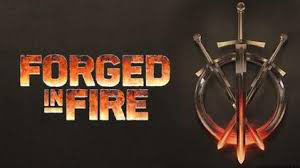Great competition shows are usually hard to come by. They are either repetitive, short-run, or very uninspired. This is where Forged in Fire stands apart. It is a competition show like no other. While it follows a similar structure as the uber-famous Chopped, the crux of the show itself is something that has never been attempted.
Forged in Fire pegs four expert bladesmith to create phenomenal blades from scratch on a time crunch for a $10,000 cash price and the title of “Forged in Fire Champion.” Each competitor creates a blade to fit certain parameters given by the judges and is often given unusual metals to work with. The show consists of three separate rounds, with one competitor being eliminated each round. The bladesmiths must use the materials and tools within the forge room until the final round. In the final round, the two remaining contestants can use their home forges and are given 5 days to create a weapon selected from history.
While watching the bladesmiths work and create stunning knives and weapons from chunks of plain metal, the real joy of this show is watching the judges test these weapons. There are usually two to three tests during the second and third rounds of each episode and they range from sharpness tests to killing tests. The judges, who are all blade experts, can push the blades to the limit to figure out who the loser of each round is to justify the winner of the episode.
Most episodes have three judges and the usual three are Doug Marcaida, the weapons specialist; J. Neilson, a master bladesmith; and Dave Baker, a renowned weapons historian. Each judge analyzes the blades and selects the best and the worst. While not every judge physically gets their chance to test the blades each episode, watching Doug Marcaida work with a blade to figure out the efficiency of the weapon is breathtaking and hearing his famous words, “it will cut” (or kill on certain occasions) is something that every contestant wants to hear.
The final challenges are by far the toughest for the contestants as they are sent home with minimal information about the weapon they are presented and are expected to use what they have available, which may not be as good as the tools in the competition forge room, to create some of the most unique weapons. This includes curved blades, exotic weapons, and many weapons that have become famous due to popular culture. They are given five days to do this and we are given a glimpse of the final two bladesmiths working with the blades. When they return, we see their blades go through rigorous testing which has a chance of completely breaking the weapon itself.
Forged in Fire is a competition show that is a breath of fresh air. While its structure is like that of Chopped, the show itself has nothing to do with cooking. Watching the bladesmiths work is awe-inspiring and makes viewers want to take up the art of weapon forging. It has amazing testing of finished blades which is simply stunning and nerve-racking to watch and the judges are all highly likable. A great show for anyone attempting to remove themselves from the averageness of the cooking competition and the repetitive and mundane shows that now being produced. The show is still going strong with new episodes and seasons being produced.

